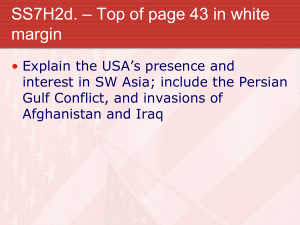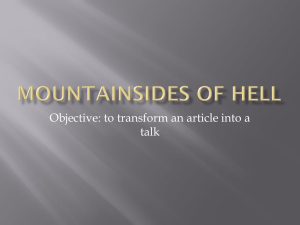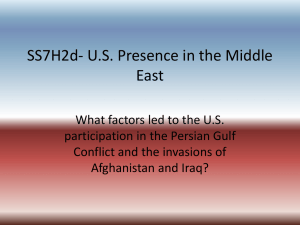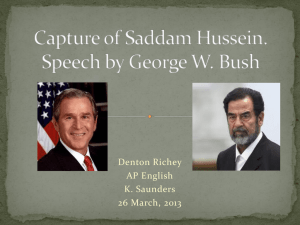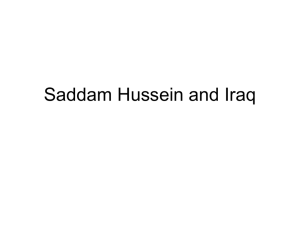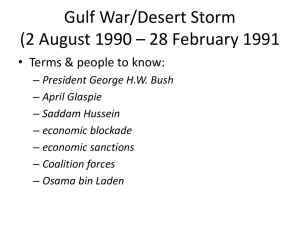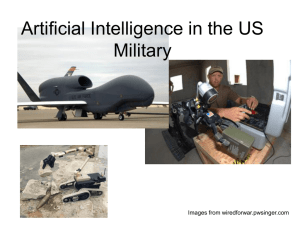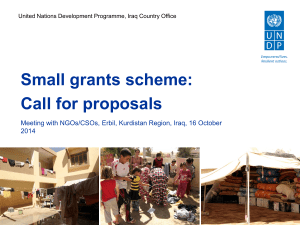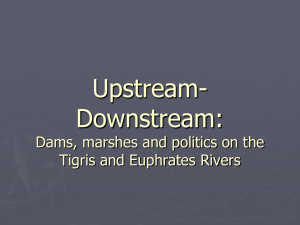Iraq PPT 1
advertisement
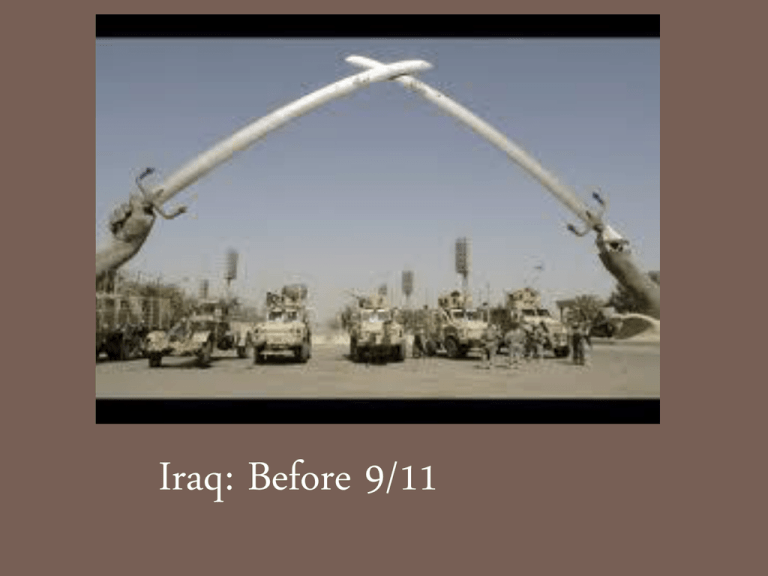
Iraq Iraq: Before 9/11 Ethnic Map of Iraq Some Facts about Iraq • Population: 26 million (down to about 22 million since the US invaded in 2003 thanks to people fleeing the violence) • Arabs (75%), Kurds (20%) • Shi’ites (65% of Iraqi Arabs) • Sunni (35% of Iraqi Arabs + nearly all Kurds) • -BUT• Under Saddam Hussein Sunnis had almost all positions of power. The Basics 1: Saddam Hussein: A bad, bad man Paranoid, brutal, corrupt, and heavily favoring his own Sunni minority, Saddam Hussein became a dictator in 1979, and led his country into virtually nonstop war and economic ruin despite Iraq’s vast reserves of oil. The Basics 2: Finding Positives • Forgetting for a moment about the war, torture, secret police, and money wasted on statues of himself, Hussein was actually a fairly progressive leader. • Under Hussein Iraq developed a modern economy, had the best education and health care in the Muslim world, the ethnic groups got along, women were educated and had almost complete equality with men, the most repressive parts of Islam were discouraged, and the capital Baghdad was called the “Paris of the Middle East”. The Basics 3: The US and Iraq (BFFs Donald Rumsfeld and Saddam Hussein) In the 1980s, despite Saddam Hussein’s brutal reign, the United States under President Reagan gave the Iraqi dictator loans, arms, military training, and chemical, biological and high-tech weapons. The US shared satellite images with Iraq so the Iraqis could use chemical weapons against Iranian troops. The US did not speak out when Hussein used poison gas against his own people, and in 1982 took Iraq off the list of countries supporting terrorism despite objections from the US State Department. One week before Iraq’s 1991 invasion of Kuwait, President Bush (the first one) vetoes Congress’ attempt to cut trade with Iraq because of its abuses of human rights. President Reagan gave Saddam Hussein a gift of cowboy spurs, and Hussein was even made an honorary citizen of the City of Detroit. The Basics 4: Why would we do that? The US supported a monster like Saddam Hussein for a few reasons: • He was more than willing to fight an eight-year war against America’s enemy Iran. • The US liked his secular ways and discouragement of hardcore Islam, so the US saw him as a counterbalance to Iran. • Arms sales were good for the US economy. • The US needed to be on good terms with someone possessing so much of the world’s oil—especially since he was willing to keep it cheap. • He was not a Communist, so Iraqi oil would not find its way to the Soviet Union. Gulf War 1: Iraq’s Crisis As the war ended in 1988, Iraq was in crisis. • Iraq had $60 billion to repay to foreign banks, • It could no longer pay for the health care, education, nearly-free food and gas, and other benefits given to its citizens in better times, • The price of oil had fallen sharply, crippling Iraq’s ability to repay its wartime debts. Gulf War 2: Kuwait Tiny Kuwait managed to poke the wounded Iraqi beast by… • EXISTING: Kuwait was created in 1963, as the British would not allow it to reunite with Iraq. The British wanted an oil-rich and grateful counterweight to Iraq, and an ally on the Persian Gulf—the waterway needed to get the oil onto tankers and out of the Middle East. The small port Iraq had on the gulf was at the mercy of the Iranian navy. • Since 1963 Iraq has maintained that the land that is Kuwait—oil-rich and strategically-placed—was taken from them. Gulf War 3: Kuwait: Not exactly innocent Kuwait also angered Iraq by: NOT NEGOTIATING: Kuwaiti banks would not give Iraq a break or renegotiate the loans it could not repay. CHEATING: Kuwait was selling more oil than agreed upon, driving down the price even more at a time when Iraq needed it high. STEALING: Kuwait was engaged in “slant drilling”, with oil wells on the border taking oil from the ground underneath Iraqi soil using American technology. TAUNTING: Knowing he had the support of the US, the Foreign Minister of Kuwait and son of the Emir (King) basically dared Saddam Hussein to do something about Kuwait’s broken promises to Iraq. Gulf War 4: The US Sends Mixed Signals • Hussein therefore began to think about using his armed forces to insist upon resolution of the border and monetary disputes. He threatened to do so about a year before the August 2nd invasion at OPEC (1) and Arab League meetings; hence the now famous meetings with Robert Dole and other US senators in April, 1990 and April Glaspie (2) in July, 1990. • At that July meeting, less than a month before the invasion of Kuwait, Hussein complained that the borders of Kuwait and Iraq were drawn in colonial times, by colonial powers. Glaspie replied, “"We studied history at school. They taught us to say freedom or death. I think you know well that we... have our experience with the colonialists. We have no opinion on the Arab-Arab conflicts, like your border disagreement with Kuwait.“(3) Basically, Hussein thought he had a green light from the US to invade Kuwait. (1) (2) (3) Organization of Petroleum Exporting Countries US Ambassador to Iraq, who was aware of Iraqi tanks amassed on the Kuwaiti border when she said this. Info for this slide taken from http://mcadams.posc.mu.edu/blog/harak.html Gulf War 5: It Begins • In August 1990, 100,000 Iraqi troops crossed the border into Kuwait. Within two days it had full control of tiny Kuwait. The rich of Kuwait fled—mostly to the luxury hotels of Paris. • Somehow, the US was shocked by this and with the overwhelming support of the American public, the US put troops in Saudi Arabia (which was scared it was next), thus beginning Operation Desert Shield. • When Iraq refused to vacate Kuwait, the US-led coalition began Operation Desert Storm to kick the Iraqi military out of Kuwait. Americans were firmly in favor of this. Gulf War 6: Iraq’s Strategy • Unable to stand up to the world’s largest and bestequipped military, Iraq tried… • Launching missiles into Israel, hoping to gain the support of other Arab countries and make it an international war. (It didn’t work.) Israel was terrified Iraq would use chemical weapons, but they did not. • Punishing Kuwait by setting their oil wells on fire. Gulf War 7: A huge victory for the US It took only a month and a half for Iraq to agree to leave Kuwait, as the US was poised to move into Iraq. Final tally: • 22,000 Iraqis dead—many of them caught in the bombing of Baghdad. Many more were wounded. • US: 113 dead, less than 1,000 wounded. Gulf War 8: before we cheer… With this decisive victory, the US still resorted to some actions of questionable morality. • The US was accused of targeting civilians in the bombing of Baghdad, including a direct hit on a neighborhood bomb shelter by a two-stage firecausing missile that killed almost 900 people. • The US used weapons made more explosive with depleted uranium, which likely caused the mystery illness called “Gulf War Syndrome”, and may account for Iraq’s high rate of cancer today. • The US bombed the traffic jam of Iraqis who were retreating back to Iraq, resulting in the carnage known as the “Highway of Death”. Hundreds of soldiers who had stopped fighting were incinerated. Gulf War 9: After the War After the war, Saddam Hussein was still in power, and killed thousands of Shi’ites and Kurds who tried to gain greater independence during the war. (The Kurds were fairly successful, the Shi’ites were slaughtered.) Much of Baghdad was destroyed, as was Iraq’s economy and infrastructure. But Saddam Hussein’s brutal government still had a firm grasp on power.
